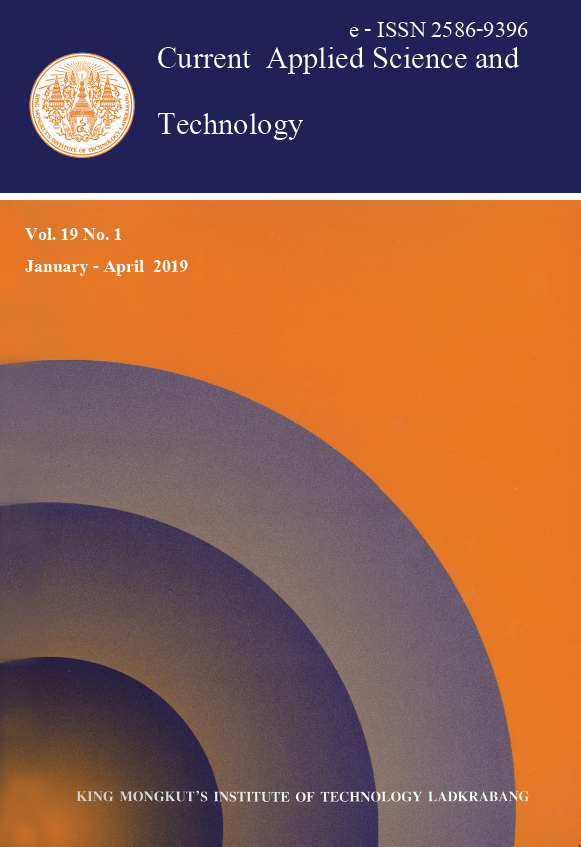Effect of Thickness of Spring Wire on the Strength and Deformation Characteristics of a Spring Steel Conduit
Main Article Content
Abstract
In automotive industry, spring steel conduit is a main part of control cables in parking brake, tailgate and transmission. The structure of spring steel conduit consists of liner, steel wire and coating. The steel wire plays an important role in supporting cable exert the force. However, steel wire thickness is concerned with the mechanical strength, flexibility and production cost. In this work, the effects of steel wire thickness on mechanical and physical characteristic of spring steel conduit were investigated. The thickness of steel wire was varied from 0.3 to 0.6 mm. The analysis was performed by JASO T001-97 standard and Hooke’s law was used to describe the spring steel conduit. The experimental result was confirmed by the compression testing and agreed with theoretical calculation. It was found that the increase in yield stress and young’s modulus, as the steel wire thickness increases. It can be found the compression force at yield that affects deformation in the spring steel conduit. The deformation and stiffness were increased as the steel wire thickness was increased. In addition, the minimize of steel wire thickness of 0.4 mm was obtained under JASO T001-97 standard, including the compression force at least 1,000 N and the safety factor of 1.5.
Keywords: Compression force; JASO T001-97 standard; tensile testing; spring steel conduit
corresponding author: E-mail: rachsak.sa@kmitl.ac.th
Article Details
Copyright Transfer Statement
The copyright of this article is transferred to Current Applied Science and Technology journal with effect if and when the article is accepted for publication. The copyright transfer covers the exclusive right to reproduce and distribute the article, including reprints, translations, photographic reproductions, electronic form (offline, online) or any other reproductions of similar nature.
The author warrants that this contribution is original and that he/she has full power to make this grant. The author signs for and accepts responsibility for releasing this material on behalf of any and all co-authors.
Here is the link for download: Copyright transfer form.pdf
References
Buthgate, S., Saenthon, A. and Kaitwanidvilai, S., 2017. Development of new part of casing cap for the parking brake cable using finite element analysis. International Journal of Innovative Computing, Information and Control, 13, 659-670.
JASO F903-75, 1975. Japanese Automobile Standard.
Musikhin, V.A., 2006. Advantages of using steel cables. Architecture, Construction. 4-5, 38-40.
Oller, S., Aramayo, S.A.O., Nallim, L.G. and Martinez, X., 2018. Composite Materials. In: I. Dincer, ed. Comprehensive Energy Systems, Vol. 2, Energy Materials. Amsterdam: Elsevier, pp. 235-265.
Geiger, M., Kleiner, M., Eckstein, R., Tiesler, N. and Engel, U., 2001. Microforming. CIRP Annals, 50(2), 445−462.
Kals, T.A. and Eckstein, R., 2000. Miniaturization in sheet metal working. Journal of Materials Processing Technology, 103(1), 95-101.
Blumenschein, L. H., McDonald, C. G. and O'Malley, M. K., 2017. A cable-based series elastic actuator with conduit sensor for wearable exoskeletons. IEEE International Conference on Robotics and Automation (ICRA), 6687-6693.
JASO T001-97, 1997. Japanese Automobile Standard.
Chou, T.-W., 1989. Flexible composites. Journal of Materials Science, 24, 761-783.
Chou, T.-W. and Takahashi, K., 1987. Nonlinear Elastic Behaviour of Flexible Fibre Composites. Composites, 18, 25-34.
Luo, S.Y. and Chou, T.-W., 1986. Modelling of the nonlinear elastic behaviour of elastomeric flexible composites. Paper presented at American Chemical Society Meeting, Anaheim, California, September 1986.
Sumikawaa, S., Ishiwataria, A., Hiramotoa, J., Yoshidab, F., Clausmeyerc, T. and Tekkayac, A.M., 2017. Stress state dependency of unloading behavior in high strength steels. International Conference on the Technology of Plasticity, ICTP 2017, 17-22.
Yoshida, F., Uemori, T., Fujiwara, K., 2002. Elastic–plastic behavior of steel sheets under in- plane cyclic tension-compression at large strain. International Journal of Plasticity, 18, 633-659.
Luo, L., Ghosh, A.K., 2003. Elastic and inelastic recovery after plastic deformation of DQSK steel sheet. Journal of Materials Processing Technolology, 125, 237-246.
Sun, L. and Wagoner, R.H., 2011. Complex unloading behavior: Nature of the deformation and its consistent constitutive representation. International Journal of Plasticity, 27, 1126-1144.
Danpinid, A., Luo, J., Vappou, J., Terdtoon, P. and Konofagou, E. E., 2009. Characterization of the stress-strain relationship of the abdominal aortic wall in vivo. 2009 Annual International Conference of the IEEE Engineering in Medicine and Biology Society, Minneapolis, 1960-1963.
Luo, Y., Wang, Q. and Yang, B., 2011. Low cycle fatigue tests on low carbon steel. 2011 International Conference on Business Management and Electronic Information, Guangzhou, 741-746.
Nguyen, N.-V., Kim, J.J. and Kim, S.-E., 2018. Methodology to extract constitutive equation at a strain rate level fromindentation curves. International Journal of Mechanical Sciences, 152, 363-377.
Sharpe, W.N., Yuan, B., Vaidyanathan, R. and Edwards, R.L., 1997. Measurements of Young's modulus, Poisson's ratio, and tensile strength of polysilicon. Proceedings of IEEE. The Tenth Annual International Workshop on Micro Electro Mechanical Systems. An Investigation of Micro Structures, Sensors, Actuators, Machines and Robots, Nagoya, Japan, 424-429.
Cruz, S.A. and Zanin, M., 2004. Assessment of dielectric behavior of recycled/virgin high density polyethylene blends. IEEE Transactions on Dielectrics and Electrical Insulation11(5), 855-860.
Heinrich, M., Sichting, F. and Kroll, L., 2012. Microinjection molding of polypropylene (PP) filled with MWCNT: Influence of processing parameters on the mechanical properties. IEEE Nanotechnology Materials and Devices Conference (NMDC2012), 111-115.
Case, J. and Chilver, A.H., 1959. Strain energy and complementary energy. Strength of Material, 18, 308-323.
Benli, S., Aksoy, S., Havıtcıoglu, H. and Kucuk, M., 2008. Evaluation of bone plate with low- stiffness material in terms of stress distribution. Journal of Biomechanics, 41, 3229-3335.


